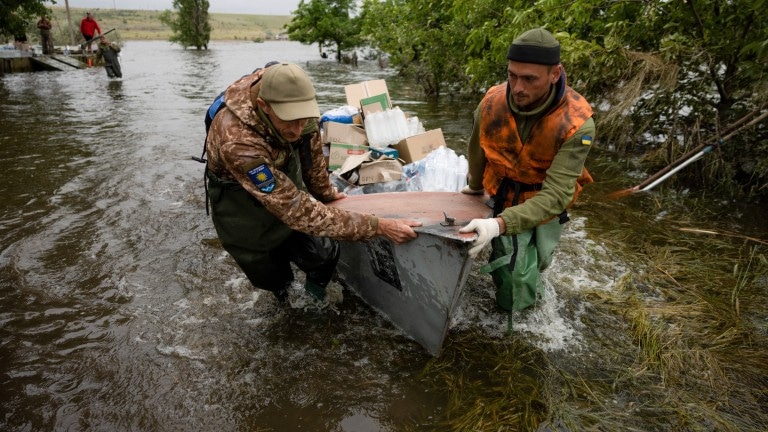Due to the large amount of precipitation throughout Europe, the water volumes coming from the Danube River are significantly superior in quantity to the water from the exploded dam
Russia has rejected a UN offer to provide aid to residents affected by flooding following the destroyed Kakhovka dam. This is claimed by the world organization, quoted by world agencies.
The death toll has risen, and polluted water has forced the closure of beaches in southern Ukraine.
The destruction of the Moscow-controlled dam on June 6 caused flooding in southern Ukraine and the Russian-occupied territories of Kherson District, destroyed homes and farmland, and cut off water supplies to the civilian population.
The death toll rose to 52, with Russian officials saying 35 people had died in Moscow-controlled areas and Ukraine’s interior ministry reporting 17 dead and 31 missing. Over 11,000 people have been evacuated from both sides.
The UN called on Russia to act in accordance with its obligations under international humanitarian law.
The Kremlin accuses Kiev of carrying out the sabotage against the water facility, whose water flow was the size of the Great Salt Lake in the US, to cut off a key source of water supply to Crimea and divert attention from a “hesitant” counter-offensive against Russian forces.
Ukraine, in turn, blames Russia for blowing up the wall of the Soviet-era dam, which has been under Russian control since the early days of the war.
A team of international legal experts assisting Ukrainian investigators in their investigation said in their preliminary findings that it was “highly likely” that the destruction of the dam in the Kherson region was caused by explosives planted by Russians.
Authorities in Odessa have banned bathing on the once-popular Black Sea beaches there, as well as the consumption of fish and seafood from unidentified sources.
Water tests carried out last week showed dangerous levels of salmonella and other “infectious agents”. Cholera monitoring was also carried out.
Although the floods have subsided, the Dnieper River, on which the Kakhovka Dam was built, has carried tons of debris into the Black Sea and along the coast of Odessa, causing an ecological disaster, according to Ukraine.
Toxic levels in marine organisms and on the seabed are expected to worsen, and the risk of landmines washed ashore increases.
As of June 29, the development of a favorable hydrodynamic situation is being observed, which currently limits the possible entry of potentially polluted waters after the demolition of the wall of the Nova Kakhovka HPP in the Bulgarian Black Sea water area and the coast. This is clear from an analysis of the Institute of Oceanology “Prof. Frittjof Nansen”.
In the last few days, the development of a favorable hydrodynamic situation has been observed, which is expressed in the fact that the jet of the coastal current in the Danube Delta region spreads in a northeast direction with a maximum speed of 35 cm/sec, i.e. a countercurrent to the prevailing transfer is formed, which holds back the spread of river waters in the Danube Delta area.
After the potentially polluted waters that entered the Black Sea through the Dnieper Bay were initially concentrated in the Gulf of Odessa, their spread gradually began in the water area of the northwestern shelf of the Black Sea, scientists from the Institute of Oceanology at the Bulgarian Academy of Sciences inform Maritime.bg.
Two streams formed. The first, in which larger volumes of water entered, was compressed by the currents and spread into the coastal area through a series of small-sized eddies.
The second includes relatively small volumes of polluted waters and gradually occupied the water area adjacent to the Crimean Peninsula. Active mixing and dispersion of pollutants took place in it.
Around June 18-19, the flow from the Odesa Bay merged with the waters coming from the Danube River, and at present they cannot be differentiated except with the availability of information or data on characteristic markers of pollution from “Nova Kakhovka” Hydroelectric Power Plant, oceanologists point out.
Currently, such markers are not available, and in this regard, the responsible institutions monitor the concentrations of specific pollutants, such as copper, zinc and aluminum, heavy metals, radionuclides and biogenic elements (nitrogen, phosphorus).
It should be borne in mind that due to the large amount of precipitation throughout Europe, the water volumes coming from the Danube River significantly exceed the amount of waters from the “Nova Kakhovka” that can potentially reach the estuary, and similarly contain biogenic elements and pollutants.
The freshwater inflow was responsible for the low coastal salinity in late May and early June, which dropped to 10-11. The salinity is currently increasing and is around 14.
In general, these are normal seasonal fluctuations, but this year they are particularly sharp due to the influx of huge volumes of fresh water from the Danube River, which further helps the dispersion of potential pollution from Nova Kakhovka, the scientists commented.
In the last few days, the development of a favorable hydrodynamic situation has been observed, which is expressed in the fact that the jet of the coastal current in the Danube Delta region spreads in a northeast direction with a maximum speed of 35 cm/sec, i.e. a countercurrent to the prevailing transfer forms, which holds back the spread of river waters in the Danube Delta area, say the IO – BAS.
A countercurrent to the prevailing transfer is formed, which prevents the spread of river waters in the Danube Delta area.
Scientists point out that the formation of an anticyclonic vortex is expected, which will characterize the water exchange in the coming days, which will also favor the retention of river waters.
The formation of an anticyclonic vortex is expected, which will characterize the water exchange in the coming days, which will also favor the retention of river waters.
The second formed flow, according to scientists, is currently intercepted by the quasi-stationary Crimean gyre, and small volumes of it enter the main Black Sea circulation system.
Very small volumes of the second flow of potentially contaminated waters that reached the Crimean Peninsula region enter the main Black Sea circulation system.
Satellite data from Sentinel 2 show that low salinity cyanobacterial blooms continue to occur in Odessa Bay. Blooms with greater intensity are also observed in the Tendriv Bay, which is not directly polluted by the waters of “Nova Kakhovka”.
The latest results of the analysis of chlorophyll in seawater show that its concentration in the Varna Bay is 2.8 times higher than that at the Krapets station. Blooming concentrations were not measured in Zlatni Piastsi and Shkorpilovtsi stations.
In the Krapets region, various species of diatoms (Cerataulina pelagica, Cyclotella meneghiniana, Dacctiylosolen fragilissimus, Chaetoceros) continue to predominate, while in the Varna Bay dinoflagellates (Gyrodinium spirale, Oblea rotunda, Gymnodinium, Gyrodinium) are found.
Scientist from Romania with hot data: Is the Black Sea polluted?
The health authorities also carry out constant monitoring of the waters near the beaches, she assured
At the moment, no pollution has been detected in the waters of the Black Sea near Romania. This was announced to Maritime.bg by Dr. Laura Boichenko, biologist, scientific director of the Romanian National Institute for Marine Research “Grigore Antipa”.
Boychenko reported that our northern neighbor also carries out constant monitoring in the Black Sea water area.
“We have a coast station near Constanta and so far no changes have been detected,” she added.
Dr. Boichenko commented that the last samples of the waters of the Black Sea were taken south of the border with Ukraine on Monday, pending the results of the tests.
“The health authorities in Romania also carry out constant monitoring of the waters near the beaches, there have been no changes in their quality,” announced the head of the Romanian institute.
According to her, both in Bulgaria and Romania, the media creates panic in the population.














